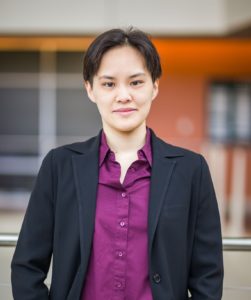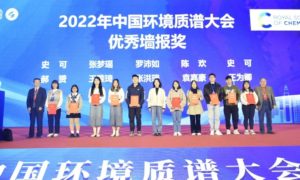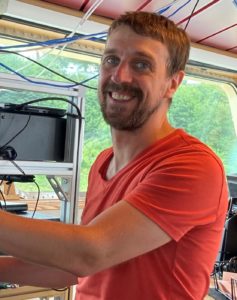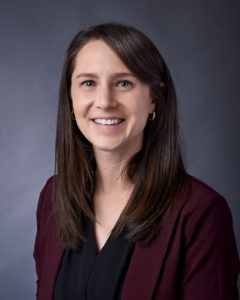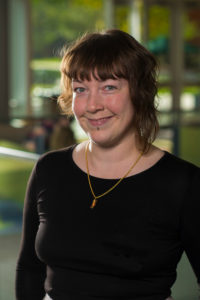
Sarah Styler obtained her BSc, MSc, and PhD from the University of Toronto and conducted postdoctoral research at the Leibniz Institute for Tropospheric Research in Leipzig, Germany. She began her independent career at the University of Alberta in 2015; in 2019, she was named a Tier 2 Canada Research Chair in Atmospheric Chemistry. In Summer 2020, she moved to McMaster University, where she is Assistant Professor of Environmental Chemistry and again a Tier 2 Canada Research Chair in Atmospheric Chemistry. She leads the P.A.R.T.I.C.L.E.S. (pesticides, art, road dust, traffic, interdisciplinary, combustion, light, equity, surfaces) research group, which currently consists of eight excellent graduate students and two stellar undergraduate trainees.
Read Sarah’s Emerging Investigator Series article “ozone uptake by urban road dust and first evidence for chlorine activation during ozone uptake by agro-based anti-icer: implications for wintertime air quality in high-latitude urban environments” and read more about her in the interview below:
Your recent Emerging Investigator Series paper focuses on ozone uptake by urban road dust. How has your research evolved from your first article to this most recent article?”
When I began my independent career in 2015, my plan was to focus on desert dust chemistry (e.g., dust–pollutant gas interactions, oxidant production by illuminated dusts). As it turns out, Edmonton is very dusty, largely as a result of resuspension of winter traction materials, so early in my career I began to focus on road dust rather than desert dust. In my group’s first article, we showed that road dust is a source of singlet oxygen, an important environmental oxidant, and thus has the potential to mediate the lifetime and fate of road dust-associated pollutants that react by singlet oxygen-mediated pathways. Motivated by these results, Maya and I decided to focus on the potential impacts of road dust chemistry on the composition of the urban troposphere. We spent much time scooping road dust from Edmonton city streets for this project, usually at weird times (to minimize traffic). Standing on a major street wearing nitrile gloves and carrying a dustpan and glass jars is a sure way to attract attention, it turns out.
During my interview for my position at the University of Alberta, I recall being asked, pointedly: what happens after dust? In other words, could I sustain a career focused on dust alone? I think that I could, but at the same time I’ve expanded my group’s research scope quite a bit over the past few years to include topics ranging from light absorption by boreal wildfire smoke to gas-phase emissions from degrading cultural heritage objects. Currently, we refer to ourselves as the P.A.R.T.I.C.L.E.S. (pesticides, art, road dust, traffic, interdisciplinary, combustion, light, equity, surfaces) group, but I anticipate this acronym will shift and change over my career!
What aspect of your work are you most excited about at the moment?
It’s difficult to choose, since each student in my group is working on such different topics (and I am enthusiastic about all of them!), but at the moment, I am most excited about work that PhD student Iris Chan is doing to quantify soiling of urban surfaces resulting from wildfire smoke incursions. This summer, we have urban surface film samplers placed in a variety of cities across Canada and the US, and I’m really looking forward to seeing what comes out of the compositional analysis of these samples Iris will perform this autumn. Of course, if you asked me on a different day, I would probably give a different answer—I maintain what sometimes seems like an inexhaustible reservoir of enthusiasm for all of the projects my group is working on.
In your opinion, what are the most important questions to be asked/answered in this field of research?
This is a difficult question! In my various biographies for conferences and websites, I usually say that my group is interested in studying the air quality, climate, and health impacts of chemical reactions at atmospheric interfaces. Impacts for whom, though? These days, I am most interested in work that aims to clearly identify and engage with the populations that experience the impacts that my research field aims to quantify. Many researchers in my field are doing really excellent work in this area—Dr. Sally Pusede (University of Virginia) comes to mind, for example. In short, I think that the most important questions are also the questions that require substantive engagement with researchers in other fields who have complementary expertise, and with community groups and organizations whose local knowledge and lived experience can ensure that we as researchers are asking the right questions and producing answers that have real value for real communities.
What do you find most challenging about your research?
Although I wouldn’t have expected this as a graduate student, the easiest part of my research is coming up with ideas. It’s the rest that causes me trouble—administration, purchasing, wrapping up the loose ends of projects. A lot of this has to do with the fact that I have ADHD, which I was diagnosed with during the first year of the pandemic. As I wrote on Twitter (@sarahannestyler) recently, I’m a poster person, not a manuscript person; I’m a relay starter, not an anchor. Working to reevaluate my strengths and my weaknesses in the context of this diagnosis has been the grand theme of my pandemic experience. I’m happy to report that my institution, colleagues, and research group have all been very supportive of these developments.
In which upcoming conferences or events may our readers meet you?
I will be attending the American Association for Aerosol Research (AAAR) meeting in Raleigh, North Carolina this October. More importantly, though, all eight of my graduate students and I will be attending the American Geophysical Union (AGU) meeting in Chicago, Illinois this December. My team is really fantastic, and I encourage readers to meet them!
How do you spend your spare time?
One of the neat things about my ADHD diagnosis is that it’s clarified why I’ve always felt like I am working constantly yet never catching up, and in a way has given me permission to take time off. Over the past year or so, I’ve been getting really interested in weaving—this past summer, I attended a two-week floor loom workshop at Haystack Mountain School of Crafts in coastal Maine. I’ve also been spending a lot of time with my family, which feels like a true luxury after five years halfway across the country and a year in Germany as a postdoc.
Which profession would you choose if you were not a scientist?
I would love to be an academic in an art history department, as I’ve always been interested in minimalist art (I made a pilgrimage of sort to the Chinati Foundation in West Texas during my MSc) and an array of other art-related topics (medieval architecture, northern European still lifes). Alternatively, I’d like to return to my undergraduate roots and work in a cafe, making three omelets at a time and baking empanadas. Or, maybe I could be a full-time weaver (assuming my skills continue to improve?!), as I like weaving’s similarity to programming and the fact that it is very, very tactile—a real counterpoint to my current working life. I am forever coming up with new ideas.
Can you share one piece of career-related advice or wisdom with other early career scientists?
I can think of many pieces of advice (not sure about the wisdom part), but the one that comes to mind right away is the importance of community. The friends that I made in graduate school are the colleagues I see at conferences and talk to on the phone, the friends I talk to about successes and failures, and the friends from whom I learn on an ongoing basis. Having a network of people with similar values and ethics continues to help me to broaden my view of the possibilities and promise of academia, especially during challenging periods.
Comments Off on Emerging Investigator Series: Sarah Styler
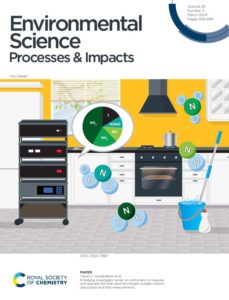 We are glad to announce that a new themed issue focusing on Indoor Chemistry is now open for submissions in Environmental Science: Processes & Impacts (ESPI). Guest edited by Rachel O’Brien (University of Michigan) and Ellison Carter (Colorado State University), the goal of this issue is to highlight research that centers around questions of the built environment, showcasing the impacts of interdisciplinary approaches.
We are glad to announce that a new themed issue focusing on Indoor Chemistry is now open for submissions in Environmental Science: Processes & Impacts (ESPI). Guest edited by Rachel O’Brien (University of Michigan) and Ellison Carter (Colorado State University), the goal of this issue is to highlight research that centers around questions of the built environment, showcasing the impacts of interdisciplinary approaches.











